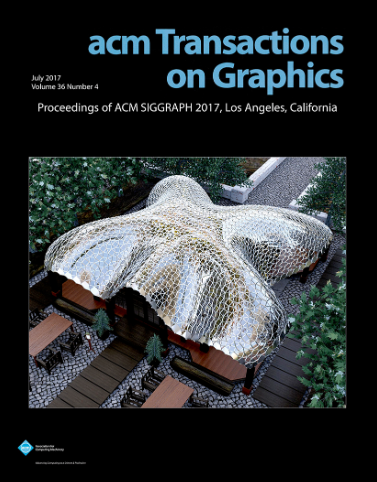3D 图层:将基于图层的色彩编辑引入 VR 绘画
IF 7.8
1区 计算机科学
Q1 COMPUTER SCIENCE, SOFTWARE ENGINEERING
引用次数: 0
摘要
将艺术作品表示为图层堆叠的能力是现代图形设计的基础,因为它允许艺术家轻松分离视觉元素,对其进行单独编辑,并将其混合以实现丰富的视觉效果。尽管图层在 2D 绘画软件中无处不在,但它们尚未进入 VR 绘画领域,在 VR 绘画中,用户可以通过手势操作 6 自由度控制器,直接在 3D 空间中绘制笔触。虽然二维图层堆叠的概念是受现实世界细胞动画中图层的启发,但三维图层应该是什么呢?我们建议将三维图层定义为三维笔触组,并将表示三维几何图形的图层与表示几何图形颜色修改的图层区分开来。我们将前者称为基底层,后者称为外观层。外观层中的笔触会修改与之相交的基底笔触的颜色。由于这种区别,艺术家可以将颜色修改序列定义为外观层堆叠,并对每一层进行独立编辑,从而精细控制基底的最终颜色。我们已将 3D 图层集成到一个 VR 绘画应用程序中,并通过对经验丰富的 VR 艺术家进行可用性研究来评估其灵活性和表现力。本文章由计算机程序翻译,如有差异,请以英文原文为准。
3D-Layers: Bringing Layer-Based Color Editing to VR Painting
The ability to represent artworks as stacks of layers is fundamental to modern graphics design, as it allows artists to easily separate visual elements, edit them in isolation, and blend them to achieve rich visual effects. Despite their ubiquity in 2D painting software, layers have not yet made their way to VR painting, where users paint strokes directly in 3D space by gesturing a 6-degrees-of-freedom controller. But while the concept of a stack of 2D layers was inspired by real-world layers in cell animation, what should 3D layers be? We propose to define
3D-Layers
as groups of 3D strokes, and we distinguish the ones that represent 3D geometry from the ones that represent color modifications of the geometry. We call the former
substrate layers
and the latter
appearance layers.
Strokes in appearance layers modify the color of the substrate strokes they intersect. Thanks to this distinction, artists can define sequences of color modifications as stacks of appearance layers, and edit each layer independently to finely control the final color of the substrate. We have integrated
3D-Layers
into a VR painting application and we evaluate its flexibility and expressiveness by conducting a usability study with experienced VR artists.
求助全文
通过发布文献求助,成功后即可免费获取论文全文。
去求助
来源期刊

ACM Transactions on Graphics
工程技术-计算机:软件工程
CiteScore
14.30
自引率
25.80%
发文量
193
审稿时长
12 months
期刊介绍:
ACM Transactions on Graphics (TOG) is a peer-reviewed scientific journal that aims to disseminate the latest findings of note in the field of computer graphics. It has been published since 1982 by the Association for Computing Machinery. Starting in 2003, all papers accepted for presentation at the annual SIGGRAPH conference are printed in a special summer issue of the journal.
 求助内容:
求助内容: 应助结果提醒方式:
应助结果提醒方式:


